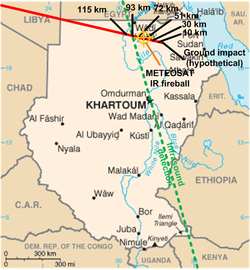
Asteroid impact prediction is the prediction of the dates and times of asteroids impacting Earth, along with the locations and severities of the impacts.
The process of impact prediction follows three major steps:
- Discovery of an asteroid and initial assessment of its orbit which is generally based on a short observation arc of less than 2 weeks.
- Follow-up observations to improve the orbit determination
- Calculating if, when and where the orbit may intersect with Earth at some point in the future.[1]
The usual purpose of predicting an impact is to direct an appropriate response.[2]
Most asteroids are discovered by a camera on a telescope with a wide field of view. Image differencing software compares a recent image with earlier ones of the same part of the sky, detecting objects that have moved, brightened, or appeared. Those systems usually obtain a few observations per night, which can be linked up into a very preliminary orbit determination. This predicts approximate positions over the next few nights, and follow-ups can then be carried out by any telescope powerful enough to see the newly detected object. Orbit intersection calculations are then carried out by two independent systems, one (Sentry) run by NASA and the other (NEODyS) by ESA.
Current systems only detect an arriving object when several factors are just right, mainly the direction of approach relative to the Sun, the weather, and phase of the Moon. The overall success rate is around 1% and is lower for the smaller objects.[note 1] A few near misses by medium-size asteroids have been predicted years in advance, with a tiny chance of actually striking Earth, and a handful of small actual impactors have successfully been detected hours in advance. All of the latter struck wilderness or ocean, and hurt no one. The majority of impacts are by small, undiscovered objects. They rarely hit a populated area, but can cause widespread damage when they do. Performance is improving in detecting smaller objects as existing systems are upgraded and new ones come on line, but all current systems have a blind spot around the Sun that can only be overcome by a dedicated space based system or by discovering objects on a previous approach to Earth many years before a potential impact.
Cite error: There are <ref group=note> tags on this page, but the references will not show without a {{reflist|group=note}} template (see the help page).